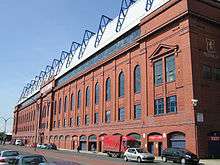Archibald Leitch
| Archibald Leitch | |
|---|---|
 | |
| Born |
27 April 1865 Glasgow, Scotland |
| Died | 25 April 1939 (aged 73) |
| Nationality | Scottish |
| Occupation | Architect |
| Projects | Bramall Lane, Arsenal Stadium, Stamford Bridge, Celtic Park, Anfield, Craven Cottage, Hampden Park, Roker Park, Old Trafford, Villa Park, Ibrox, Goodison Park, White Hart Lane, Fratton Park |
Archibald "Archie" Leitch (27 April 1865 – 25 April 1939) was a Scottish architect, most famous for his work designing football stadiums throughout the British Isles.[1]
Early work
Born in Glasgow, Leitch's early work was on designing factories in his home city and in Lanarkshire, with the sole surviving example being the category A listed Sentinel Works at Jessie Street, Polmadie, just south of Glasgow city centre. In 1896 he became a member of the Institution of Engineers and Shipbuilders in Scotland, and later of the Institution of Mechanical Engineers.[2] He moved into stadium design when he was commissioned to build Ibrox Park, the new home ground of his boyhood heroes Rangers, in 1899.
Stadium design
Leitch's stadia were initially considered functional rather than aesthetically elegant, and were clearly influenced by his early work on industrial buildings. Typically, his stands had two tiers, with criss-crossed steel balustrades at the front of the upper tier, and were covered by a series of pitched roofs, built so that their ends faced onto the playing field; the central roof span would be distinctly larger, and would incorporate a distinctive pediment.
His first project in England was the design and building of the John Street Stand at Bramall Lane, which provided 3,000 seats and terracing for 6,000 and was dominated by a large mock-Tudor press box.




Even after the Ibrox disaster of 1902, when 26 people were killed when a bank of terracing collapsed, Leitch was still in demand. Over the next four decades he became Britain's foremost football architect. In total he was commissioned to design part or all of more than 20 stadiums in the UK and Ireland between 1899 and 1939, including:
- Anfield, Liverpool
- Arsenal Stadium, Highbury, London
- Ayresome Park, Middlesbrough
- Bramall Lane, Sheffield
- Cardiff Arms Park, Cardiff
- Craven Cottage, Fulham, London
- Dalymount Park, Dublin
- Deepdale, Preston
- The Old Den, New Cross, London
- Dens Park, Dundee
- The Dell, Southampton
- Ewood Park, Blackburn
- The Double Decker stand (The Kop), Filbert Street, Leicester
- Fratton Park, Portsmouth
- Goodison Park, Liverpool
- Hampden Park, Glasgow
- Home Park, Plymouth
- Ibrox Park, Glasgow
- Hillsborough Stadium, Sheffield
- Lansdowne Road, Dublin
- Leeds Road, Huddersfield
- Molineux, Wolverhampton
- Old Trafford, Trafford, Greater Manchester
- Park Avenue, Bradford
- Roker Park, Sunderland
- Rugby Park, Kilmarnock
- Saltergate, Chesterfield
- Selhurst Park, South Norwood, London
- Somerset Park, Ayr
- Stamford Bridge, Walham Green, London fulham
- Starks Park, Kirkcaldy
- Twickenham Stadium, Twickenham, London
- Tynecastle Stadium, Edinburgh
- Valley Parade, Bradford (Midland Road stand and other extensions)
- Villa Park, Birmingham
- West Ham Stadium, Custom House, London
- White Hart Lane, Tottenham, London
- Windsor Park, Belfast
Many of his works have since been demolished for redevelopment (especially in wake of the Taylor Report and the move to all-seater stadiums), most notably the Trinity Road Stand at Villa Park, considered his masterpiece, which was demolished in 2000. The main stand and pavilion at Craven Cottage, the main stand at Tynecastle and the facade of the main stand at Ibrox (although the stand itself has been remodelled) still survive to this day; all are now listed buildings.
References
- ↑ "The chronicles of Archibald Leitch: Remembering Britain's legendary football architect".
- ↑ "Dictionary of Scottish Architects - DSA Architect Biography Report (November 7, 2015, 2:04 pm)". scottisharchitects.org.uk.
- ↑ "Reinforced Concrete Football Stand at Bradford", Concrete and Constructional Engineering, Vol. V., No. 1, January 1910, pp. 16-22.
Further reading
- Inglis, Simon (2005). Engineering Archie: Archibald Leitch - Football Ground Designer. English Heritage. ISBN 1-85074-918-3.
- Whitehead, Richard (18 April 2005). "Man who built his place in history". London: The Times.
- Oxford University Press | Biography
External links
- Explore Glasgow - All round the city Features architectural elevations of all Leitch's stadiums in Glasgow.